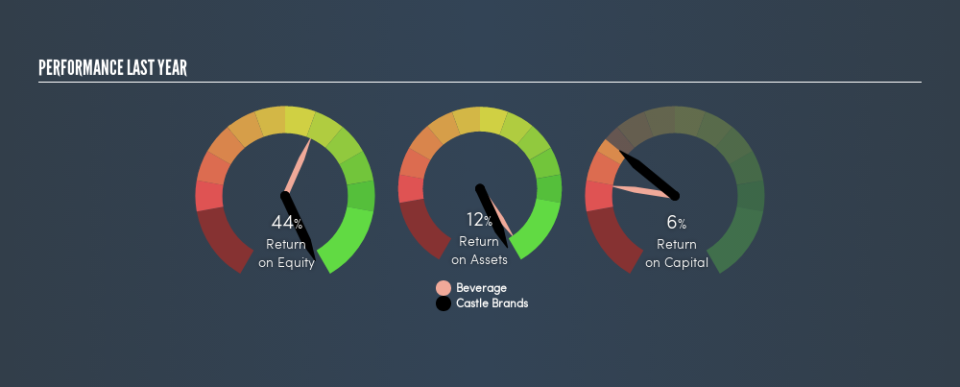Shareholders Should Look Hard At Castle Brands Inc.’s (NYSEMKT:ROX) 5.9% Return On Capital

Today we'll evaluate Castle Brands Inc. (NYSEMKT:ROX) to determine whether it could have potential as an investment idea. In particular, we'll consider its Return On Capital Employed (ROCE), as that can give us insight into how profitably the company is able to employ capital in its business.
First up, we'll look at what ROCE is and how we calculate it. Then we'll compare its ROCE to similar companies. Last but not least, we'll look at what impact its current liabilities have on its ROCE.
Understanding Return On Capital Employed (ROCE)
ROCE is a measure of a company's yearly pre-tax profit (its return), relative to the capital employed in the business. Generally speaking a higher ROCE is better. In brief, it is a useful tool, but it is not without drawbacks. Renowned investment researcher Michael Mauboussin has suggested that a high ROCE can indicate that 'one dollar invested in the company generates value of more than one dollar'.
So, How Do We Calculate ROCE?
The formula for calculating the return on capital employed is:
Return on Capital Employed = Earnings Before Interest and Tax (EBIT) ÷ (Total Assets - Current Liabilities)
Or for Castle Brands:
0.059 = US$3.9m ÷ (US$85m - US$18m) (Based on the trailing twelve months to June 2019.)
Therefore, Castle Brands has an ROCE of 5.9%.
Check out our latest analysis for Castle Brands
Does Castle Brands Have A Good ROCE?
ROCE is commonly used for comparing the performance of similar businesses. We can see Castle Brands's ROCE is meaningfully below the Beverage industry average of 10%. This performance is not ideal, as it suggests the company may not be deploying its capital as effectively as some competitors. Separate from how Castle Brands stacks up against its industry, its ROCE in absolute terms is mediocre; relative to the returns on government bonds. Readers may find more attractive investment prospects elsewhere.
In our analysis, Castle Brands's ROCE appears to be 5.9%, compared to 3 years ago, when its ROCE was 2.3%. This makes us wonder if the company is improving. The image below shows how Castle Brands's ROCE compares to its industry, and you can click it to see more detail on its past growth.
Remember that this metric is backwards looking - it shows what has happened in the past, and does not accurately predict the future. ROCE can be deceptive for cyclical businesses, as returns can look incredible in boom times, and terribly low in downturns. This is because ROCE only looks at one year, instead of considering returns across a whole cycle. Since the future is so important for investors, you should check out our free report on analyst forecasts for Castle Brands.
Castle Brands's Current Liabilities And Their Impact On Its ROCE
Liabilities, such as supplier bills and bank overdrafts, are referred to as current liabilities if they need to be paid within 12 months. The ROCE equation subtracts current liabilities from capital employed, so a company with a lot of current liabilities appears to have less capital employed, and a higher ROCE than otherwise. To counter this, investors can check if a company has high current liabilities relative to total assets.
Castle Brands has total assets of US$85m and current liabilities of US$18m. Therefore its current liabilities are equivalent to approximately 22% of its total assets. This very reasonable level of current liabilities would not boost the ROCE by much.
What We Can Learn From Castle Brands's ROCE
If Castle Brands continues to earn an uninspiring ROCE, there may be better places to invest. You might be able to find a better investment than Castle Brands. If you want a selection of possible winners, check out this free list of interesting companies that trade on a P/E below 20 (but have proven they can grow earnings).
For those who like to find winning investments this free list of growing companies with recent insider purchasing, could be just the ticket.
We aim to bring you long-term focused research analysis driven by fundamental data. Note that our analysis may not factor in the latest price-sensitive company announcements or qualitative material.
If you spot an error that warrants correction, please contact the editor at editorial-team@simplywallst.com. This article by Simply Wall St is general in nature. It does not constitute a recommendation to buy or sell any stock, and does not take account of your objectives, or your financial situation. Simply Wall St has no position in the stocks mentioned. Thank you for reading.

 Yahoo Finance
Yahoo Finance 
